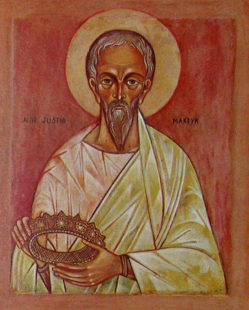A Sunday Service in the 2nd Century: A Description from Justin Martyr
Justin Martyr is a name unfamiliar to many. However, Justin Martyr would have been very familiar in early Christianity. He was a first-class Christian apologist, and in his writings, he defended the peacefulness of Christians by describing the practices of the church around 150 A.D. (within 60 years of the Apostle John’s death). Although he is not an inspired writer, his observations are interesting in many regards. Does worship in the 2nd-century church look similar to our churches today? I find the testimony of Justin Martyr particularly insightful in answering questions like that (First Apology, 67, ca. 150 A.D.).

Justin Martyr on the Order of Service
In his observations, Justin Martyr captures a typical Sunday service as it would have unfolded in the early church—a time marked by learning and extended times of worship. The description offers a structured portrayal of early Christian gatherings. The congregation would come together, often in homes or local spaces, and begin by listening to the “memoirs of the apostles” or readings from the prophets, immersing themselves in the teachings that formed the basis for their doctrine and faith. After the readings, the leader, or “president,” would offer a message of encouragement and instruction, urging the congregation to emulate the virtues they had just heard.
On the day called Sunday there is a gathering together in the same place of all who live in a given city or rural district. The memoirs of the apostles or the writings of the prophets are read, as long as time permits. Then when the reader ceases, the president in a discourse admonishes and urges the imitation of these good things. Next we all rise together and send up prayers.
When we cease from our prayer, bread is presented and wine and water. The president in the same manner sends up prayers and thanksgivings, according to his ability, and the people sing out their assent, saying the ‘Amen.’ A distribution and participation of the elements for which thanks have been given is made to each person, and to those who are not present they are sent by the deacons.
Justin Martyr on Giving
The role of giving within the early church, as outlined by Justin Martyr, shows a community committed to mutual care and practical support. Contributions were voluntary, each member giving according to their means. Funds collected were entrusted to the president, who then distributed resources to care for those in need—orphans, widows, the sick, prisoners, strangers, and anyone facing hardship.
Those who have means and are willing, each according to his own choice, gives what he wills, and what is collected is deposited with the president. He provides for the orphans and widows, those who are in need on account of sickness or some other cause, those who are in bonds, strangers who are sojourning, and in a word he becomes the protector of all who are in need.
It should be noted that this practice of giving, not merely as charity but as a deliberate act of fellowship, reinforces the early church’s commitment to being unified as a protective family. Very early giving was seen as a central expression of the faith, meeting needs in tangible and practical ways.
Justin Martyr on Why the Church Gathered on Sunday
Justin Martyr further explains why Christians gathered on Sunday, a practice born of significant theological meaning. Sunday commemorated both the creation of the world and Christ’s resurrection, connecting the weekly rhythm of worship with two foundational events for Christians. By gathering on this day, the early church honored the day on which Christ rose, grounding their practice in a weekly celebration of life, renewal, and hope.
But Sunday is the day on which we all hold our common assembly, because it is the first day on which God, having wrought a change in the darkness and matter, made the world; and Jesus Christ our Savior on the same day rose from the dead. For He was crucified on the day before that of Saturn (Saturday); and on the day after that of Saturn, which is the day of the Sun, having appeared to His apostles and disciples, He taught them these things, which we have submitted to you also for your consideration.
For modern Christians, Sunday worship maintains this legacy of celebrating the resurrection, anchoring weekly gatherings in a practice dating back almost two millennia. Justin Martyr’s account ought to remind today’s churchgoers that our Christian forebearers had very good reasons for coming together on Sunday. In following this rhythm, believers align themselves with a practice that not only commemorates Christ’s resurrection but also celebrates the new life that comes through faith.
Conclusion
While Justin Martyr’s words are not scriptural or inspired, his descriptions provide a window into the life of the early church and demonstrate a consistency with Scripture that still has application today. From the focus on Scripture and prayer to the practice of communion and giving, his accounts resonate with much of what we still practice in our own contemporary contexts. Justin Martyr’s observations remind us that the church’s core practices and gatherings are not merely traditions but deeply grounded practices rooted in Scripture that have been honored across centuries by faithful brothers and sisters. I personally think it is rather neat to hear about how the early church conducted itself. It is encouraging to see there are many similarities in our own application of the New Testament in modern times.

One Comment
J. Neil Lipscomb
A very succinct, excellent overview!